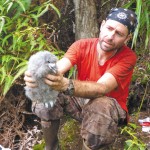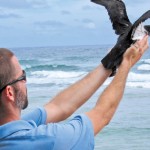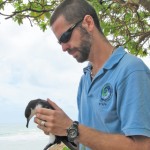Help For Kauai’s Feathered Friends
Native seabird populations that once covered the entire island have plummeted tragically in recent decades.
“You’re looking at only a shadow of what used to be,” explains André Raine, Kauai Endangered Seabird Recovery Project (KESRP) coordinator.
Raine spends his days perched atop mountain ranges only accessible by helicopter studying the behaviors of the critically endangered Newell’s shearwater (ao), Hawaiian petrel (uau) and band-rumped storm petrel (akeake). His team is learning about these endemic creatures in hope of snatching them from the brink of extinction.
- André Raine gets hands-on — and techie too — to save Kauai’s native seabirds from extinction. Photo courtesy André Raine
- Raine releases a rescued fledgling Newell’s shearwater back to the ocean. Photo by Coco Zickos
- Raine with a radar truck that detects the flight path of seabirds as they cross from the mountains to the ocean
- Fledgling Newell’s shearwater, like this one held by Raine, become disoriented by bright lights, which interrupt their inaugural flight to sea. Photo by Coco Zickos
- Students from Eleele Elementary School recently attended a re-releasing ceremony for a Newell’s shearwater that had been downed and rescued. They are (from left) Noah Bueno, Dennis Dumlao, Wailenalena Kaohi, Pi’ilani Buyat, Makala El Saieh-Rowe, Keisha Suga and Makana Nishikuni (Photo by Nathan Banfield)
The birds are an integral part of the island’s ecosystem and helped create Kauai’s lush landscape thousands of years ago, prior to the arrival of people.
“Think about the past, and vast numbers of birds flying from the sea and their guano in the watersheds crafting forests,” explains Raine. “And when you start removing them, who knows what the consequences are.”
In fact, one thing scientists at KESRP (a Division of Forestry and Wildlife project) currently are studying is just how much that input from bird excretions (phosphorous and nitrogen) still impacts the forests. Other studies underway include placing “song meters” that capture the sounds of seabirds, letting scientists know how their numbers change over time. They’ve also installed state-of-the-art cameras that snap successive photos of the birds at their burrows (the birds are unaware), allowing scientists a sneak peek into their elusive lives. Predators like cats, rats and even pigs are among the findings these cameras have recorded at nesting sites, which has helped biologists gain insight into ways these issues can be rectified, such as installing predator-proof fencing to protect the birds. KESRP also is working alongside Kauai Island Utility Cooperative to mitigate the number of adult birds impacted by power lines on their regular flights to and from the sea.
“Chances are, sooner or later, they’re going to hit one, especially if it’s dark or foggy,” says Raine.
This time of year, however, the greatest impacts to their populations occur when fledglings are disoriented by bright lights (which everyone is advised to turn off when not in use from now until mid-December). On their inaugural flight to sea, Newell’s shearwater come from the darkest depths of the mountains and are confused by bright lights, and innocently mistake them for the moon, which they instinctually follow on their way to the ocean, where they will spend the next several years.
“They have it hard,” says Raine. “I find it quite amazing that the birds actually manage to fledge their chicks in the face of all the different things they face.”
But even though their populations continue to dwindle, there is a glimmer of hope.
“There are solutions on the horizon,” he says. “We just have to work hard to figure out what they are and get them in place.”
Raine, a native of Bermuda, has been working to restore seabird populations since he was 17. He achieved his ornithology-based Ph.D. at University of East Anglia in the U.K.
“I’ve always been fascinated by the wild world, and all of the impacts humans have on it are normally fairly devastating,” he laments.
Before moving to Kauai, he was studying another shearwater species on Malta in the Mediterranean Sea. He’s had his current job for three years, and loves living on the Garden Isle with wife Helen and their two children Callum and Maya.
During his time with KESRP, Raine’s focus on conservation and management has allowed his team to learn a great deal about Kauai’s seabirds, particularly Newell’s shearwater.
“I think they do have a chance,” he notes. “I think there is a positive outlook for the species, and I think we’re working toward it and we’ll get there.
“We’ve got to make sure they’re still up there in the mountains for generations to come because it would be extremely sad if all of our endemic species disappear from this island — that’s what makes the island special.”
If you find downed seabirds during fledgling season from now through December, please bring them to any of the Save Our Shearwaters aid stations located across the island (at most fire stations). For a list of drop-off sites, visit kauaihumane.org/services/saveourshearwaters. Go to kauaiseabirdproject.org for more information about KESRP.
cocomidweek@gmail.com







